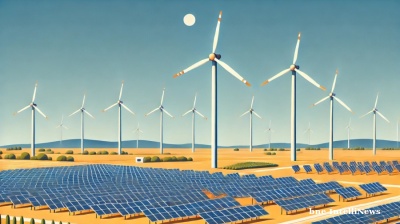A recent study finds that the AMOC (Atlantic Meridional Overturning Circulation) is on course to stop flowing, at the latest, within the next 75 years, causing a mini-ice age in Europe and could disrupt the entire planet's weather patterns.
The AMOC is an ocean current that carries warm water from the equator to the northern hemisphere, raising the average temperatures, especially in winter. However, large amounts of freshwater flowing into the sea as the ice cap melts are threatening to halt the current, which will lead to significantly colder temperatures. Winter temperatures in winter could fall to -30C, making Berlin and London as cold as Siberia.
Moreover, the knock-on effects of changing the temperature of the oceans will affect rain patterns around the world and could cause a cascade of environment disasters across the planet.
“These AMOC-induced precipitation changes could severely disrupt the ecosystem of the Amazon rainforest and potentially lead to cascading tipping,” according to a paper in Science Advances on a physics-based early warning signals that shows that AMOC is on tipping course.
“The Northern Hemisphere shows cooler temperatures after the AMOC collapse, while the opposite is true for the Southern Hemisphere, although not all changes are significantly different (due to large interannual variability).”
But it is clear that Northern Europe will see the biggest changes. Temperatures have already fallen in Europe during the industrial period due to a 1C increase in temperatures that has already occurred. And the tipping point will be sudden when it happens, as it is related to the difference in the weight of salty water to fresh water: at some point there is not enough energy to push the warm salt water along and the current simply stops.
It remains unclear when this will happen, but other studies have found that there is a 95% possibility of the AMOC halting by 2095 if global warming is not arrested.
“Although AMOC collapses have been induced in complex global climate models by strong freshwater forcing, the processes of an AMOC tipping event have so far not been investigated. Here, we show results of the first tipping event in the Community Earth System Model, including the large climate impacts of the collapse,” according to the authors of the paper.
The new study dives into the physics of the AMOC. It starts with an assumption of an AMOC strength of approximately 15 sverdrups (15mn cubic metres of salt water per second), estimates this equates to about 1 petawatt (PW) of heat transported northwards annually, equivalent to 32 zettajoules (ZJ) of heat per year.
That is a lot of energy. The total world energy consumption in 2021 was about 580 exajoules, so the AMOC carries north the equivalent of 55-times the entire global energy production each year, or 2.5 trillion households’ worth of energy, or 500mn Hiroshima nuclear bomb explosions.
When the AMOC ceases, this immense heat transfer will come to an abrupt halt. The impact of the change will be immediate, catastrophic and irreversible.
The study, along with previous research, suggests that substantial fresh water input from increased rainfall and Greenland fresh water ice melt could potentially disrupt the AMOC within this century, and the AMOC flow rate is already visibly slowing.
“With a decrease in meridional heat transport, we might expect accelerating Antarctic sea ice loss and a slow down in Arctic ice loss. That's what models predict and what we are observing,” says Lee Simons, a climatologist.

As more fresh water is added as meltwater and rainfall, which is also on the increase, the AMOC's speed decreases, with the tipping point in the model occurring at around 0.5 sverdrups (500,000 cubic metres of water per second) of fresh water input.
This potential tipping point is within reach given the current volume of fresh water available and the amount of heat needed to melt the Greenland ice sheet to cause it, calculates Simons.
Greenland contains 2.85mn cubic kilometres of ice, capable of providing approximately 170 years of 0.5 sverdrups of fresh water, which would result in a global sea level rise of over seven metres. To melt this volume of ice for a year requires 5.3 ZJ of heat – or a sixth of the energy that the AMOC carries north each year.
Since 1970, human-induced greenhouse gas (GHG) emissions have contributed an additional 450 ZJ of heat to the Earth's system, with around 90% absorbed by the oceans. The study notes that while aerosols from coal plants and sulphur-rich fuel burning have reduced this heat accumulation, the current trend of reducing aerosols is leading to increased heat accumulation and the climate models are wrong as a result, underestimating the rate of acceleration of the Climate Crisis. As a result, the North Atlantic region has experienced a significant spike in absorbed sunlight in recent years, adding 4 ZJ of heat over 12 months – a bit less than what is needed to melt the glaciers.
This has contributed to a record-high global Earth Energy Imbalance (EEI) – the difference between the amount of energy the earth radiates into space and the amount it absorbs from the sun – of about 1.8 watts per square metre (W/m²) in 2023, adding 29 ZJ of heat to the Earth's system annually.
During the Paris climate summit in 2015, all the attention was focused on warming effects of GHGs, but the increased warming by the sun is a new and underestimated global factor that is becoming more important as time passes as a result of the removal of aerosols (SO2) that mostly used to be emitted by burning ship fuel until a clean-up that was started in 2020.
“This accumulation of heat suggests the conditions are present to melt sufficient Greenland ice to potentially shut down the AMOC. Additionally, increased precipitation further contributes to the fresh water input,” says Simons. "Sorry I couldn't make this more hopeful, but numbers don't lie."
The study concludes that the continued increase in GHG concentrations and reduction in aerosols only exacerbate the climate forcing and the Earth's energy imbalance, pushing the AMOC closer to its tipping point.
bneGREEN

Kyrgyzstan says neighbours “upset” by country’s lack of water
“This year we were supposed to overcome shortages, but instead, they have intensified,” deputy head of cabinet tells Uzbekistan and Kazakhstan.

EXPLAINER: What is the EU’s CBAM and how will it affect global trade from 2026?
The European Union’s Carbon Border Adjustment Mechanism (CBAM) will enter its full operational phase on January 1, 2026, marking a major shift in global climate and trade policy.

Iran faces critical water crisis after driest year in five decades
Iran faces critical water crisis after driest year in five decades with 40% nationwide rainfall drop.

Global renewables to double by 2030, but IEA warns momentum must accelerate
Global renewable energy capacity is on course to double by 2030, reaching 4,600 GW—comparable to the current combined total of China, the European Union and Japan—according to the International Energy Agency’s Renewables 2025 report.




